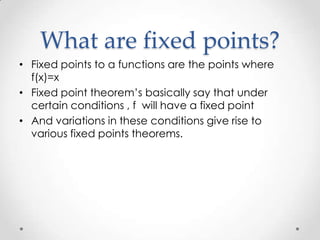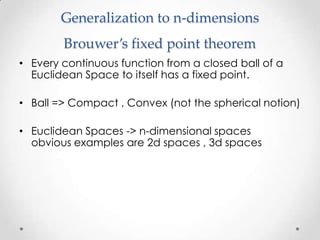Fixed Point Theorems
- 1. Fixed Point Theorems a gentle introduction Annual Seminar Week IITB
- 2. Overview âĒ Some History âĒ What are fixed points(FP)? âĒ The statement of Brouwerâs Fixed point theorem o The hairy ball theorem âĒ Coffee cup , hurricanes , and maps âĒ An interesting construction of FPâs in a very restricted case
- 3. What are fixed points? âĒ Fixed points to a functions are the points where f(x)=x âĒ Fixed point theoremâs basically say that under certain conditions , f will have a fixed point âĒ And variations in these conditions give rise to various fixed points theorems.
- 4. The obvious fixed point theorem âĒ Every function that maps to itself in one dimension has a fixed point (a.k.a. the Intermediate-value theorem) x2 x1 x1 x2
- 5. Generalization to n-dimensions Brouwerâs fixed point theorem âĒ Every continuous function from a closed ball of a Euclidean Space to itself has a fixed point. âĒ Ball => Compact , Convex (not the spherical notion) âĒ Euclidean Spaces -> n-dimensional spaces obvious examples are 2d spaces , 3d spaces
- 6. Hairy Ball theorem âĒ You can't comb a hairy ball flat without creating a cowlick!
- 7. Some implications âĒ Fixed point in a coffee cup!
- 8. Some implications âĒ There is always a hurricane somewhere on the earth! âĒ This follows from the hairy ball theorem and the fact that wind is a continuous transform . âĒ Brouwerâs FPT is used by John Nash (âA beautiful mindâ) to prove the existence of Nash-Equilibrium
- 9. Some implications âĒ In computer graphics we sometimes need a continuous function that generates an orthogonal vector to a given vector. âĒ The hairy ball theorem implies that there is no such function!
- 10. A Stronger FP theorem Kakutani Fixed point theorem âĒ Constraint in Brouwerâs FP theorem is modified such that now the function is mapping to a subset of itself(closed ball).
- 11. Geometrical Construction of fixed point, in a map overlay âĒ Two maps of different sizes of a country are arranged on a table such that one of them lies on top of the other and is completely inside it. âĒ FP in this setting would be a point on the table where both the maps point to the same location. âĒ We use the fact that line joining FP to the vertices makes the same angle in both the cases with a corresponding edge of the map âĒ And then some pure geometry !











